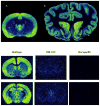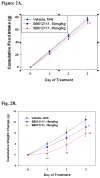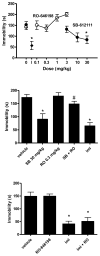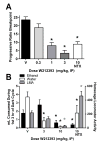The biology of Nociceptin/Orphanin FQ (N/OFQ) related to obesity, stress, anxiety, mood, and drug dependence
- PMID: 24189487
- PMCID: PMC5098338
- DOI: 10.1016/j.pharmthera.2013.10.011
The biology of Nociceptin/Orphanin FQ (N/OFQ) related to obesity, stress, anxiety, mood, and drug dependence
Erratum in
- Pharmacol Ther. 2014 Sep;143(3):351
Abstract
Nociceptin/Orphanin FQ (N/OFQ) is a 17 amino acid peptide that was deorphanized in 1995. The generation of specific agonists, antagonists and receptor deficient mice and rats has enabled progress in elucidating the biological functions of N/OFQ. Additionally, radio-imaging technologies have been advanced for investigation of this system in animals and humans. Together with traditional neurobehavioral techniques, these tools have been utilized to identify the biological significance of the N/OFQ system and its interacting partners. The present review focuses on the role of N/OFQ in the regulation of feeding, body weight homeostasis, stress, the stress-related psychiatric disorders of depression and anxiety, and in drug and alcohol dependence. Critical evaluation of the current scientific preclinical literature suggests that small molecule modulators of nociceptin opioid peptide receptors (NOP) might be useful in the treatment of diseases related to these biological functions. In particular, the literature data suggest that antagonism of NOP receptors will produce anti-obesity and antidepressant activities in humans. However, there are also contradictory data discussed. The current literature on the role of N/OFQ in anxiety and addiction, on the other hand points primarily to a role of agonist modulation being potentially therapeutic. Some drug-like molecules that function either as agonists or antagonists of NOP receptors have been optimized for human clinical study to test some of these hypotheses. The discovery of PET ligands for NOP receptors, combined with the pharmacological tools and burgeoning preclinical data set discussed here bodes well for a rapid advancement of clinical understanding and potential therapeutic benefit.
Keywords: (1S,3aS)-8- (2,3,3a,4,5,6-hexahydro-1H-phenalen-1-yl)-1-phenyl-1,3,8-triaza-spiro[4.5]decan-4-one, a NOP receptor agonist; (±)trans-1-[1-cyclooctylmethyl-3-hydroxymethyl-4-piperidyl]-3-ethyl-1,3-dihydro-2H-benzimidazol-2-one, a NOP receptor antagonist; 2-{3-[1-((1R)-acenaphthen-1-yl)piperidin-4-yl]-2,3-dihydro-2-oxo-benzimidazol-1-yl}-N-methylacetamide, a NOP receptor agonist; 5-HT; 5-hydroxytryptamine or serotonin; 8-[bis(2-methylphenyl)-methyl]-3-phenyl-8-azabicyclo[3.2.1]octan-3-ol; ACTH; Alcohol-preferring rats; Anxiety; BED; BNST; CGRP; CPP; CRF; CTA; Calcitonin gene related peptide; CeA; DA; Depression; Drug dependence; EPSC; FST; G-protein activated, inwardly rectifying K(+) channel; G-protein-coupled receptor; GIRK; GPCR; HPA; J-113397; JTC-801; KO; MDD; Marchigian Sardinian Alcohol-Preferring; N-(4-amino-2-methylquinolin-6-yl)-2-(4-ethylphenoxymethyl)benzamide hydrochloride, a NOP receptor antagonist; N/OFQ; NAcc; NE; NOP; NPY; Nociceptin opioid peptide or Nociceptin opioid peptide receptor; Nociceptin/Orphanin FQ; Nociceptin/Orphanin FQ (F: phenylalanine, Q: glutamine, the amino acids that begin and end the peptide sequence); ORL; Obesity; P rats; POMC; Pro-opiomelanocortin; Ro 64-6198; SB-612111; SCH 221510; SCH 655842; Stress; TST; UFP-101; VTA; W212393; [(–)-cis-1-methyl-7-[[4-(2,6-dichlorophenyl)piperidin-1-yl]methyl]-6,7,8,9-tetrahydro-5H-benzocyclohepten-5-ol, a NOP receptor antagonist; [Nphe(1),Arg(14),Lys(15)]N/OFQ-NH(2), a NOP receptor antagonist; adrenocorticotropic hormone; bed nucleus of stria terminalis; binge eating disorder; central nucleus of the amygdala; conditioned place preference; conditioned taste aversion; corticotrophin-releasing factor; dopamine; endo-8-[bis(2-chlorophenyl)methyl]-3-phenyl-8-azabicyclo[3.2.1]octane-3-carboxamide, a NOP receptor agonist; excitatory post-synaptic current; forced-swim test; hypothalamic–pituitary axis; knockout; mPFC; major depressive disorder; medial prefrontal cortex; msP; neuropeptide Y; norepinephrine; nucleus accumbens; opioid-receptor-like; tail-suspension test; ventral tegmental area.
© 2013.
Figures







Similar articles
-
Ro 64-6198 [(1S,3aS)-8-(2,3,3a,4,5,6-Hexahydro-1H-phenalen-1-yl)-1-phenyl-1,3,8-triaza-spiro[4.5]decan-4-one] acts differently from nociceptin/orphanin FQ in rat periaqueductal gray slices.J Pharmacol Exp Ther. 2004 Nov;311(2):645-51. doi: 10.1124/jpet.104.070219. Epub 2004 Jul 13. J Pharmacol Exp Ther. 2004. PMID: 15254141
-
Nociceptin/orphanin FQ receptor antagonists as innovative antidepressant drugs.Pharmacol Ther. 2013 Oct;140(1):10-25. doi: 10.1016/j.pharmthera.2013.05.008. Epub 2013 May 24. Pharmacol Ther. 2013. PMID: 23711793 Review.
-
Pharmacological characterization of the nociceptin/orphanin FQ receptor antagonist SB-612111 [(-)-cis-1-methyl-7-[[4-(2,6-dichlorophenyl)piperidin-1-yl]methyl]-6,7,8,9-tetrahydro-5H-benzocyclohepten-5-ol]: in vitro studies.J Pharmacol Exp Ther. 2007 Jun;321(3):961-7. doi: 10.1124/jpet.106.116764. Epub 2007 Feb 28. J Pharmacol Exp Ther. 2007. PMID: 17329552
-
Nociceptin/orphanin FQ peptide receptor antagonist JTC-801 reverses pain and anxiety symptoms in a rat model of post-traumatic stress disorder.Br J Pharmacol. 2015 Jan;172(2):571-82. doi: 10.1111/bph.12701. Epub 2014 Jul 1. Br J Pharmacol. 2015. PMID: 24666365 Free PMC article.
-
Nociceptin/orphanin FQ peptide receptors: pharmacology and clinical implications.Curr Drug Targets. 2007 Jan;8(1):117-35. doi: 10.2174/138945007779315605. Curr Drug Targets. 2007. PMID: 17266536 Review.
Cited by
-
Identification of significant gene biomarkers of low back pain caused by changes in the osmotic pressure of nucleus pulposus cells.Sci Rep. 2020 Feb 28;10(1):3708. doi: 10.1038/s41598-020-60714-y. Sci Rep. 2020. PMID: 32111963 Free PMC article.
-
Nociceptin/Orphanin FQ Receptor Structure, Signaling, Ligands, Functions, and Interactions with Opioid Systems.Pharmacol Rev. 2016 Apr;68(2):419-57. doi: 10.1124/pr.114.009209. Epub 2016 Mar 8. Pharmacol Rev. 2016. PMID: 26956246 Free PMC article. Review.
-
Effects of Stress Exposure to Pain Perception in Pre-Clinical Studies: Focus on the Nociceptin/Orphanin FQ-NOP Receptor System.Brain Sci. 2024 Sep 19;14(9):936. doi: 10.3390/brainsci14090936. Brain Sci. 2024. PMID: 39335430 Free PMC article. Review.
-
Assessment of the Abuse Potential of Cebranopadol in Nondependent Recreational Opioid Users: A Phase 1 Randomized Controlled Study.J Clin Psychopharmacol. 2019 Jan/Feb;39(1):46-56. doi: 10.1097/JCP.0000000000000995. J Clin Psychopharmacol. 2019. PMID: 30531478 Free PMC article. Clinical Trial.
-
A Survey of Molecular Imaging of Opioid Receptors.Molecules. 2019 Nov 19;24(22):4190. doi: 10.3390/molecules24224190. Molecules. 2019. PMID: 31752279 Free PMC article. Review.
References
-
- Anderberg UM, Liu Z, Berglund L, Nyberg F. Plasma levels on nociceptin in female fibromyalgia syndrome patients. Z Rheumatol. 1998;57(Suppl 2):77–80. - PubMed
-
- Barrot M, Marinelli M, Abrous DN, Rouge-Pont F, Le Moal M, Piazza PV. Functional heterogeneity in dopamine release and in the expression of Fos-like proteins within the rat striatal complex. Eur J Neurosci. 1999;11:1155–66. - PubMed
Publication types
MeSH terms
Substances
Grants and funding
LinkOut - more resources
Full Text Sources
Other Literature Sources
Research Materials
Miscellaneous

